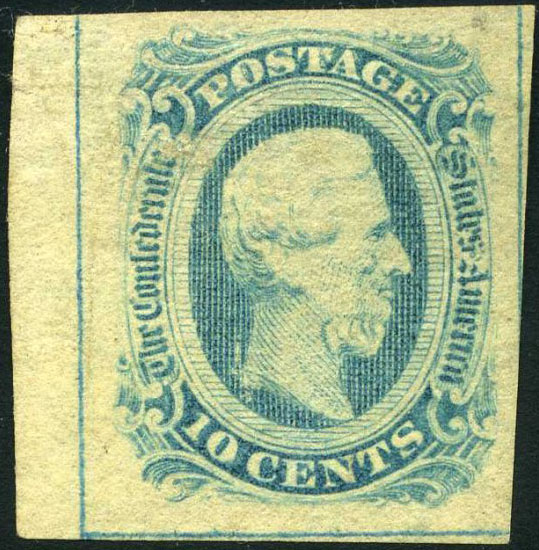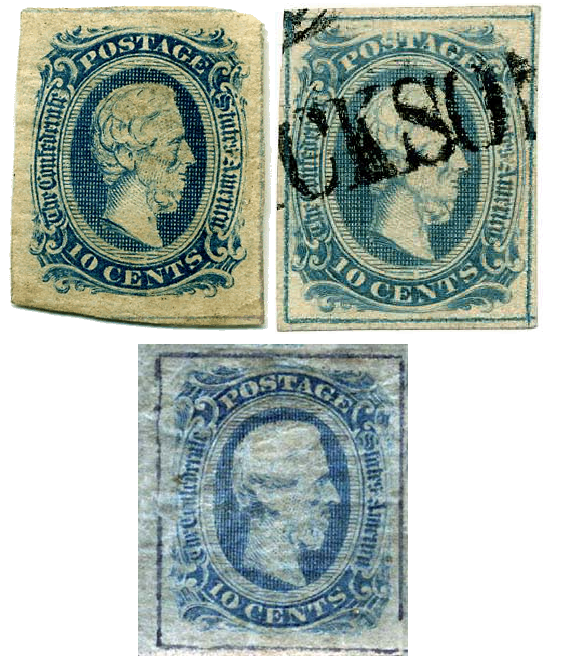
Genuine Frame Line
Check the design types!
The first thing that should be looked for is the most obvious. Is the Frame Line a Type I 10-cent design? If it is Type II, it cannot be a genuine Frame Line . Fakes are even known with the T-E-N design, which should also be rather obvious. Both are a dead giveaway that what you have cannot be a genuine Frame Line. Look for the plate flaw above the "N" of "CENTS". It is thought that the transfer was damaged during the making of this plate. Consequently, some stamps do not exhibit the flaw, some have been recut to fix the flaw, and some exhibit the flaw, but there will be no filled in corner ornaments and other tell-tale signs of Type II. (See the "Trouble Spots" tutorial on this website if you don't know the difference between CSA 11 and 12).
The following example is exactly such a creature. What is really scary about this is that it was offered on eBay as item number 220230651195 in May 2008 and WITH a "good" 1972 Philatelic Foundation certificate, illustrated following it. I am confident that the Foundation would never make such a mistake today, but it goes to show that even certificates from respected organizations are no guarantee. Your best protection is your own knowledge. In spite of protests from multiple respected Confederate students, this stamp was still offered for sale on eBay / at public auction. It caused their very own expert to resign in protest when eBay refused to listen to him on this as well as other matters. Caveat emptor!


Check the color of the frame lines
The next thing to look for in detecting fakes of the Frame Line is to examine the color of the lines and compare them to the color of the stamp. This will usually expose the fake immediately. Unfortunately, scanners typically do not capture the true color of stamps well, and color also depends on the computer monitor used. Thus, this method is seldom very dependable when looking at scans alone. The stamps themselves must be examined. If the lines are obviously a different color, you should assume that the item is fake. If the colors appear to match, other characteristics should be used to evaluate the stamp further. If you hadn't guessed, the illustrated Frame Line stamps have drawn-in lines, which are darker or lighter in color than the rest of the design and not raised (engraved).

The quality of the lines should be examined. They should be straight and smooth, of fairly even thickness and not significantly inclined. If the lines are shaky or wavy, the lines most likely have been painted by hand. On the plate that produced the #10, lines were applied by drawing an engraver's burin along a straightedge. There were places where the lines may be slightly thicker due to repositioning the straightedge and restarting the burin, but the lines should still be straight. Immersion in water may reveal faked lines, as most of the fakes lines were ruled in water color ink. Four frame lines? Almost never. An immediate danger signal. On the first two examples at least they managed to put them on a type I stamp, but the third example not only has obviously wavy lines, it is a type II design and an uncharacteristic frameline color.

Left: Genuine Frame Line, CSA 10 - Right: Totally BOGUS, the entire design is incorrect
Check the details of the actual stamp design and lettering
The frame lines themselves are not the only things to check. The stamp design itself may be entirely bogus. The stamp above on the left is the genuine Frame Line stamp with part of one frame at left. A similar "stamp" compared on the right, also with a single frame at left, is dramatically different when compared to the genuine. Note the difference in the beard, the curve of the cheek, the eye, the shading below the bottom of the hairline and all of the lettering. There are too many differences to count. The "pretender" on the right was substantially "roughed up" to lend credibility - creases, stains, trace of frame line, etc. But the many designs differences and paper difference give it away.
One of the most common forgeries is the Springfield reproduction of the Frame Line, CSA 10
The Springfield Facsimile

The Springfield Frame Line, CSA 10, is particularly easy to note by the four full frames
and the writing at lower left below the frame line "Curtis Collection", clearly proclaiming it a facsimile.
Springfield Facsimiles: These are the most commonly encountered of forgeries. Many years ago, a complete set of counterfeits were made up and marketed by a Tatham Stamp Company in Springfield, Massachusetts in 1934 in the guise of being "educational products"; these are known as "Springfield Facsimiles." The yellowish paper of the Springfield reproductions is of a different texture than the genuine stamp. Frequently, this difference is apparent in the images used on eBay where they are offered in profusion and usually, but not always, described as facsimiles. There is a distinct woven texture that is not present on the genuine stamps. The face of the stamps is not a clear printing as would be expected from a copper engraved plate printing. Detail present in the original is lacking in the flat looking reproduction.
PAY ATTENTION! If you are reading these pages because you know nothing about stamps and want to find out what you have, please flip the stamp over and look at the back. Often the word "FACSIMILE" or "REPRODUCTION" is found on the back in various ink colors, often a very pale strike. If so, you need go no further. That is what you have. I often end up speaking to people on the phone who are sure they have a rare four Frame Line stamp (almost never found with four full frames as genuine). If they had only paid attention to our telephone conversation and turned the stamp over, they could have saved further effort.
Catalog Numbers are from the Confederate States of America Catalog and Handbook of Stamps and Postal History